Grow bags are a fantastic way to cultivate sweet potatoes. You must be well informed about the Best Grow Bags for Sweet Potatoes as well as the 6-Step Process involved in planting them.
In this article, we will also look at the pros and cons of each, caring advice for your sweet potato, and the best way to harvest them. So, let’s get started!
Contents
Quick Care Guide on How to Grow Potatoes in Grow Bags
This table provides the full detail you need to know about sweet potatoes.
Scientific name: | Ipomoea batatas |
Classification: | Vegetables |
Common names: | Sweet Potatoes |
Hardiness: | Annual |
Temperature: | 75° to 95°F (24-35°C) |
Flowers: | The interior is usually purple or blue, while the rest of the flower is white |
Light: | 12-14 daily hours of sunlight during growing months |
Water: | 3/4-1 inch of rain per week |
Humidity: | During the curing process is 90-95% humidity level After curing, relative humidity of 85 percent to 90 percent |
Fertilizer: | Potassium, Phosphate, Nitrogen |
Fertilizer usage: | 1.25 to 2.25 pounds per foot |
Soil: | Well-drained sandy loam |
Diseases: | Fusarium root and stem rot, powdery mildew |
Pest: | Sweet potato weevil, flea beetles, cucumber beetles |
Harvesting period: | 100-160 days |
Our Recommended Grow Bags
In this section, we would be describing the features of our five best-recommended grow bags including their pros and cons so you can choose the right one for you. so let’s dive into it one after the other.
The table below shows the comparison of our best-recommended bags based on material, size, shape etc.
Name: | Cavisoo 5-Pack | GORDITA Grow Bags 4-Pack | Gardzen 6-Pack BPA-Free |
Photo: | |||
Material: | Non woven fabric | Fabric | Fabric |
Diameter: | 14’’ | 35.99cm’ | 13.8’’ |
Height: | 18’’ | 39.98cm’’ | 17.3’’ |
Shape: | Cylindrical | Cylindrical | Round |
Mount: | Fabric window mount | Hanging | Velcro window mount |
Special features: | Drainage hole | Light weight | Drainage hole |
Rating: | |||
Available: |
1. Cavisoo 5-Pack 10 Gallon Potato Grow Bags
Cavisoo 5-Pack is a 10 Gallon Garden planting bag suitable for potatoes, it has thickened nonwoven Fabric Pots that provide an ideal growth environment for plants’ moisture, nutrition, and temperature.
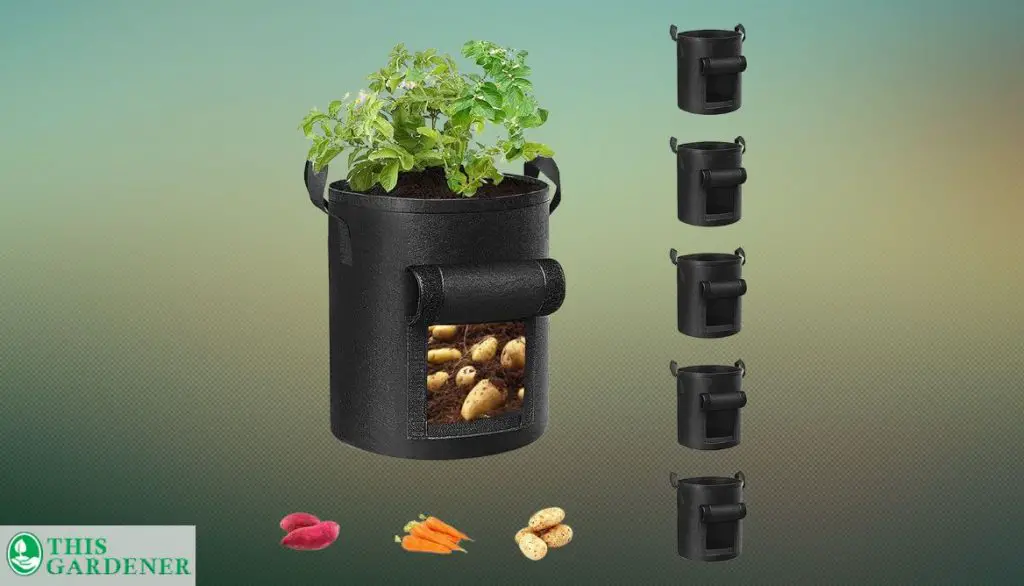
Material: | Non woven fabric |
Diameter: | 14 inches |
Height: | 18 inches |
Shape: | Cylindrical |
Mount: | Window |
Material
These planting bags are constructed of 300g thick non-woven cotton and durable handles that are made of strong polypropylene webbing.
Features
- It has a visualization window that gives room for harvesting them directly.
- Cavisoo 5-Pack grow bag provides excellent ventilation and good breathability, which can provide sufficient breathing space for the roots, and effectively avoid root circling.
- It has reinforced handles with X-shaped stitching that can bear more weight and support a full bag of soil.
- High-quality breathable material
- Excellent drainage holes
- Easy to store
- Reinforced and Durable handles
- Visualized Design
- Durable for more than three years
- Heavy-duty bag
- The price is a little expensive
- The size of the visualized window is small
- These bags are not suited for a large variety of potatoes
- It is not BPA-free potato grow bag
- It can get rip easily because it made from fabrics
2. GORDITA Grow Bags 4 Pack Potato Grow Bags with Flap
The vegetable grow bag has a robust handle that allows you to effortlessly move it from indoors to outdoors or from one location to another. The grow bags pots are simple to clean and when not in use, they can be folded and stored. It is lightweight, robust, and reusable for years. Gordita bags weighs 1.08 kg.
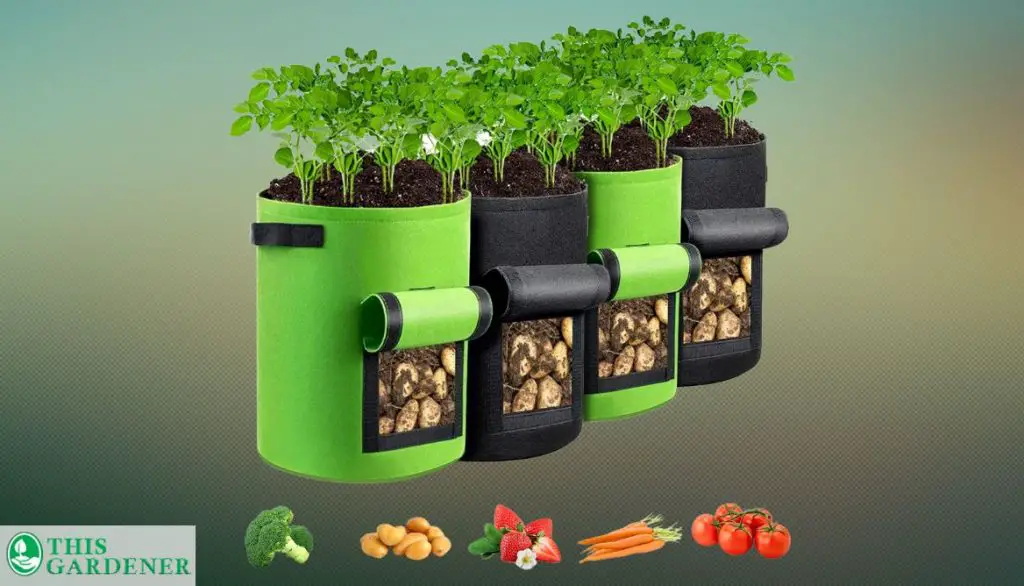
Material: | Non woven fabric |
Diameter: | 35.99 cm |
Height: | 39.98 cm |
Shape: | Cylindrical |
Mount: | Hanging |
Material
Gordita potato planter is composed of high-quality double strong non-woven fabric that prevents overwatering and promotes vigorous plant growth.
Features
- Each vegetable grow bag has a sturdy handle that allows you to effortlessly transport it from indoors to outdoors or from one location to another.
- Adopting a big harvest window design, 10-gallon potato grow bags not only allow you to carefully view the developing process of plant roots.
- It is also more convenient for you to collect the potato through the window than digging in the soil.
- Easy to move and use
- Large window design
- Breathable material
- Strong handles
- Easy to clean and store
- Affordable compared to other grow bag
- Useful for other domestic purposes
- Lightweight
- It is a large size grow bag
- Heavy-duty planting bag
- Need frequent watering
- It is not BPA-free potatoes bag
3. Gardzen 6 Pack BPA-Free 10 Gallon Vegetable Grow Bags
The Gardzen 6 Pack BPA is made of BPA-free extreme-duty cloth with sturdy webbing handles. It comes in a pack of six 10-gallon bags and has a weight of 3.08 pounds.
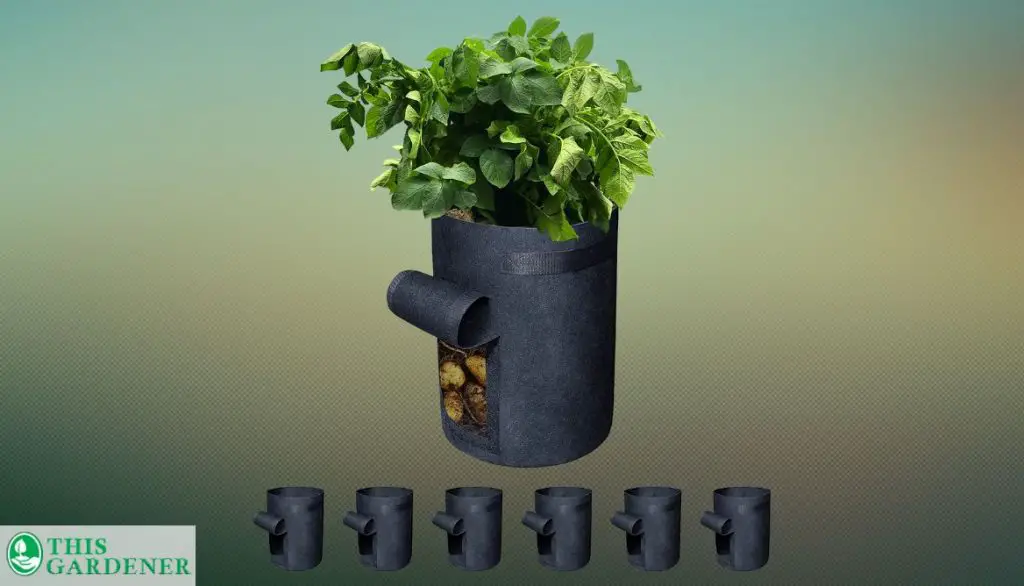
Material: | Fabric |
Diameter: | 13.8 inches |
Height: | 17.3 inches |
Shape: | Round |
Mount: | Window |
Material
Gardzen 6 Pack BPA features a permeable fabric that allows for easy water drainage and air movement.
Features
- Hand-stitched seams and rip-resistant carry handles facilitate movement.
- It has a Large velcro window for harvesting potatoes so there is no need for a garden or digging.
- Easy to store and move around
- BPA-free heavy-duty fabric bags
- Heavy duty fabric
- Very useful for Urban gardeners
- Suitable for all seasons
- Strong webbing handles
- Rip-resistant carry handles
- Large velcro window
- Easy drainage system
- The sizes and capacity are not usually up to 10 gallons as specified.
- It is very prone to tear and wear due to the nature of fabric grow bag.
4. Homyhoo Potato Grow Bags with Flap 10 Gallon
These vegetable garden bags are much better at controlling the temperature and water content of your growing medium than traditional plastic pots. In the cold, the fabric will keep your plant warmer, and in the hot sun, your plant will be kept cooler, so it doesn’t overheat.
It is durable and each bag may hold roughly 4 to 6 seed potato plants.

Material: | Non woven fabric |
Diameter: | 13.8 inches |
Height: | 17.8 inches |
Shape: | Round |
Mount: | Window |
Material
Homyhoo Potato Bags is made of breathable double-layer non-woven fabric and high-duty felt. It promotes good ventilation to prevent excessive wetness and provides more oxygen to your plants.
Features
- Homyhoo Potato garden Bags have a wide window that allows you to check on your plants and strong handles that make it easy to move around as needed.
- Homyhoo Potato bags fold up conveniently and take up little storage space.
- The flap and lid made it easy to harvest potatoes with little effort.
- Premium double-layer fabric
- Breathable material
- Large harvest window
- Relatively cheap compared to others
- Easy harvesting of tubers
- Strong handles
- Easy to move, store and reuse
- Suitable for all places
- It can not accommodate large quantities of sweet potatoes
- it can easily wear and tear off if not carefully pulled
5. Thickened Nonwoven Fabric Pots and Vegetable bags
Fabric pot helps roots to breathe and grow healthier, resulting in increased plant growth and yields. It weighs 3.19 pounds. It is so strong and long-lasting that it can last up to five seasons.
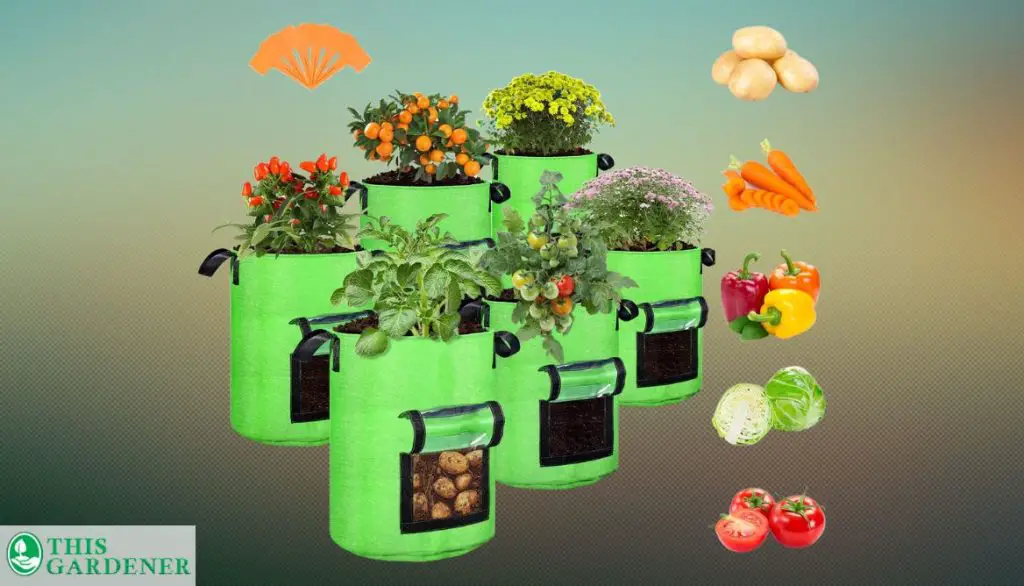
Material: | Dual-window |
Diameter: | 13.3 inches |
Height: | 18 inches |
Shape: | Cylindrical |
Mount: | Window |
Material
These are thickened fabric pots constructed of breathable fabric material that is non-woven but moderately permeable, with a two-sided Harvest Visualization window and a durable handle. Unlike other sweet potato bags, this one allows you to view the plant’s progress in greater depth and clarity.
Features
- Fabric pot has a handle strap that is sturdy and longer than those of other bags.
- Planter bags with neat seams handle at the top that prevents ripping and allows you to effortlessly move it. It contains 6 pieces in a pack.
- Fabric pots make plants grow quickly and you can harvest the potato more easily with two windows saving time and energy.
- Saves time and energy
- It has dranaige holes
- Non woven breathable material
- Two-sides flap window for easy harvesting of sweet potatoes
- Large Capacity and Durable
- Sturdy Handle Straps
- Eco-friendly
- Reusable and durable
- Reinforced stitching and double sewing
- It is the most costly compared to others
- It is prone to ripping if care is not properly taken
Growing Sweet Potatoes in Garden bags – Step-By-Step Process
Here, we will explore and share some of the finest strategies to grow sweet potatoes so that you can have a fruitful crop, thus read to the finish to acquire a complete knowledge of planting sweet potato.
Planting Tips to Keep in Mind: Grow Sweet Potatoes
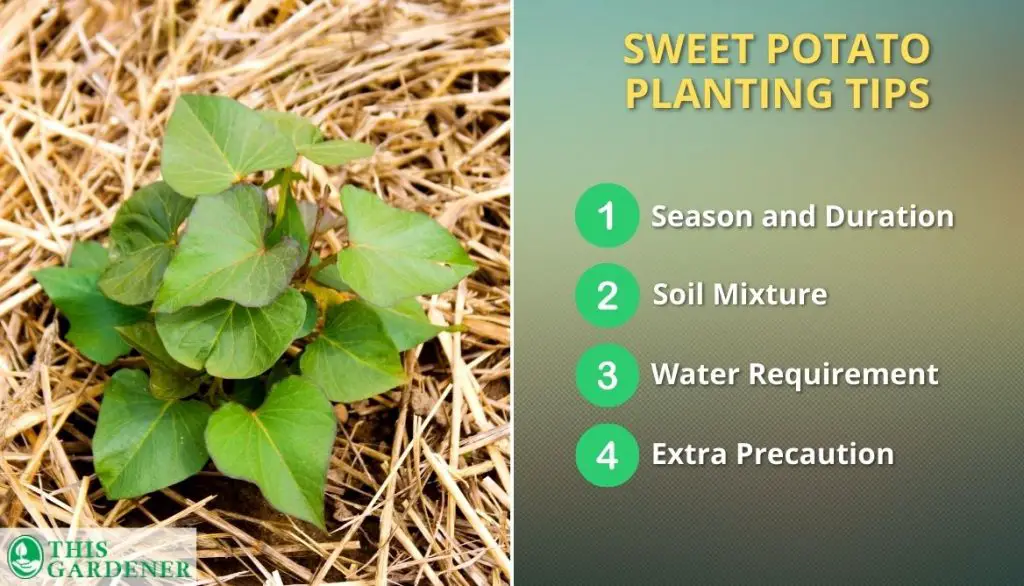
1. Season and Duration
Sweet potatoes have a relatively long growing season, lasting between 100 and 140 days. The best time to plant potatoes is in early spring, preferably two to three weeks before the last frost date in cold temperatures. They can be sown in the fall in warmer climates.
2. Soil Mixture
The potting soil should be fertile and well-drained, and the soil mix should also be high in organic matter. So before planting, potting soil mixed with compost or manure boosts fertility. Large tubers require a lot of soil space to grow and keep new tubers covered with soil to avoid greening or sunscald.
3. Water Requirement
Sweet potato plants require a lot of water during their growing season, especially during hot weather, as well as mulching to keep them moist and cool. It is essential to choose a bright place in your garden when planting. They require at least six hours of direct sunlight per day.
4. Extra Precaution
Always watch out for pests, especially chewing insects, which can reduce plant vigor. Uncover a little tuber every now and then to check for any damage to the baby potato. You are unlikely to have serious soil-borne bug problems if you utilize clean, new compost.
Step-by-Step Process to Grow Sweet Potatoes at Home in Planting Bags
Here’s all you need to put in place when planting potatoes.
- Potato garden bag
- Adequate soil to fill in the Bag indoors
- High-quality fertilizer
- Sweet potato slips
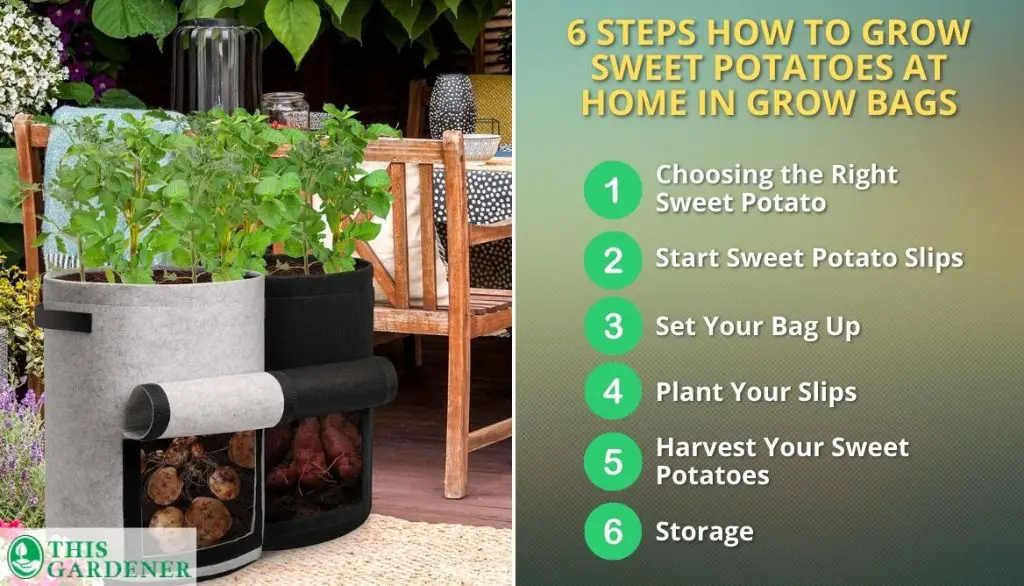
Step 1: Choosing the Right Sweet Potato
Choosing the right sweet potato for planting starts with your preference to the very best-yielding variety as well as the maturity or harvesting duration of varieties available within your reach.
Step 2: Start Sweet Potato Slips
There are some tips to start potato slips easily.
The fast approach to Plant Sweet potatoes slip
The quickest and simplest approach is to manufacture your own sweet potato slips by burying the smooth in a pot of soil nicely aerated or in a jar of water on your kitchen windowsill. Change the water every few days. Your potatoes should start to have sprouted roots.
The Growth of slips
After a few weeks, the sprouted vines should be about six inches long. Smaller potatoes work best and should be done in about 8 weeks before planting. If you need your slips right away, keep the pot in a warm, bright spot and water it regularly.
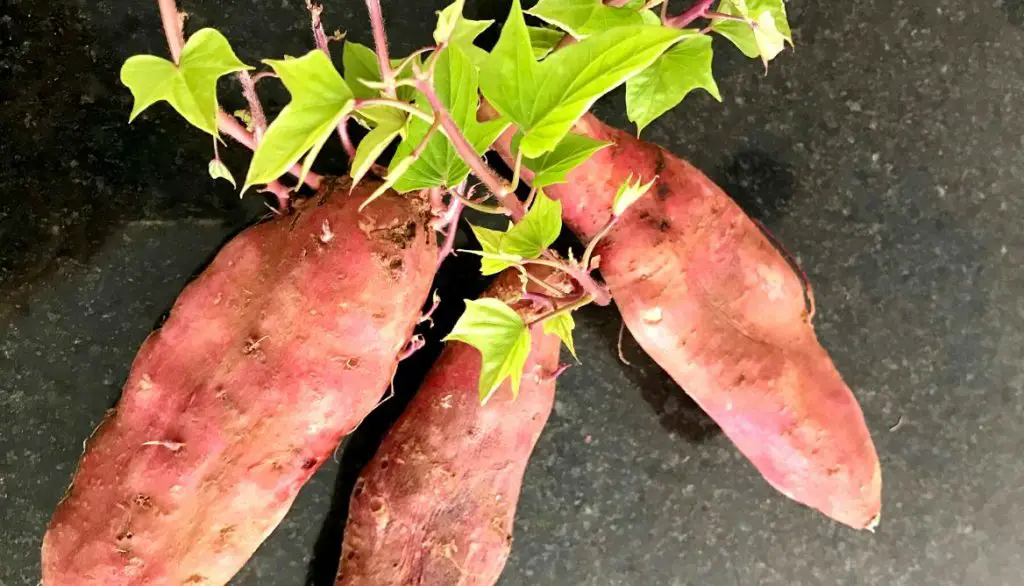
Sprouting of sweet potato slips
Sprouting in the soil is normally faster, but if you don’t like cleaning up after dealing with soil within your home, you may sprout in water.
Step 3: Set Your Bag Up
Fill a grow bag with multipurpose compost, loamy soil, or potting mix to about an inch below the rim leaving about 2 inches of space at the top because Sweet potatoes require a lot of space to grow.
Step 4: Plant Your Slips
Follow the tips to plant your slips.
Preparation of slip
To begin growing sweet potatoes you need to get plant slips outside 3 to 4 weeks after your last spring frost, or when the soil temperature has reached at least 65°F (18°C). The slips should be between 6 to 12 inches long with a number of leaves and roots. Place the whole slip in bags that contain at least 3 inches of light, organic, well-draining soil.
Planting of slips
The slips should be planted 12-18 inches apart in rows 3-4 feet apart. Temperatures at night should be at least 55°F (13°C). The trick is to plant them early. Allow them to fully mature, but not too early that they are killed by a late April frost.
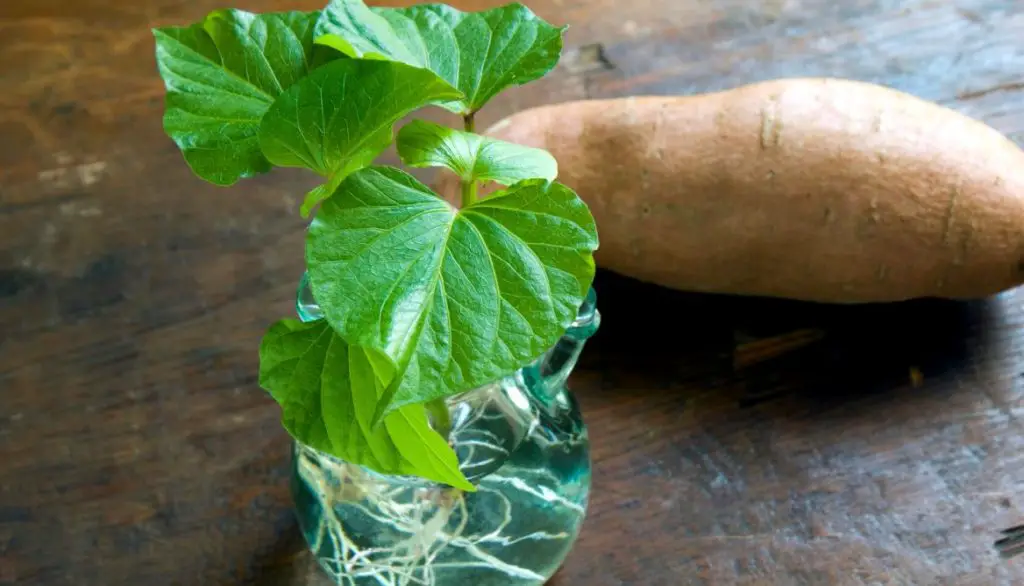
Step 5: Harvest Your Sweet Potatoes
After 100 days the leaves would have turned yellow and started to die, your tubers should be ready to harvest as the tubers are now 5 to 6 inches long and 2 inches in diameter. When harvested late in the winter, tuber in dead vines tends to rot.
Step 6: Storage
Sweet potatoes should be stored in a cool, dark, and damp environment. It is best to keep the pantry or cabinet out of the direct sun.
If you reside in a warm climate, Raw sweet potatoes such as white potato and yellow can stay for up to two weeks in your refrigerator and three months in your fridge just make sure to cover it in a paper towel or newspaper to absorb any extra moisture.
Types of Planting Bags that Work Well for Sweet Potatoes
Planting bags made of recyclable and durable materials such as fabric, cotton, Polyethylene, and plastics with drainage holes and windows mounted for optimal monitoring and simple harvesting are ideal.
Type of Sweet Potatoes You Should Grow
In the table below, we have compiled the 27 top-yielding varieties from across the world, each with their own individual flavor and color, as well as their maturation time. You can choose which one to grow based on your preferences, flavor, weather conditions in your area, sensitivity to pests and diseases, and harvesting period.
Common Names | Duration |
Bayou Belle | 90-110 days |
Bellevue | 110-120 days |
Burgundy | 115-120 days |
Georgia Jet | 100 days |
O’Henry | 90-100 days |
Hernandez | 115-120 days |
Porto Rico | 110 days |
Murasaki | 100-120 days |
Garnet | 100-110 days |
Okinawan purple | 120-180 days |
Vardaman | 110 days |
Stokes Purple | 120-140 days |
Purple Passion | 120 days minimum |
Jewel | 115-120 days |
Beauregard | 90-100 days |
Centennial | 90-100 days |
Covington | 110-120 days |
Charleston Purple | 100-120 days |
Sumor | 110-120 days |
Porto rico | 110 days |
Nancy Hall | 110-120 days |
Mahon yam | 90 days |
Korean purple | 120-135 days |
Heart O’Gold | 90 days |
Hannah | 110 days |
Evangeline | 100-120 days |
Covington | 95-110 days |
Instructions for Planting Sweet Potato Slips
- Purchase your sweet potato slips from a trustworthy provider to ensure that they are disease-free and grow true to variety.
- Begin by preparing loamy, well-drained soil. Add 1-4″ of compost to the top of the soil in your bag and loosen the lower layers with a broad fork. Next, make 6″ deep furrows 36-42″ apart with your hands or the back of a garden tool.
- Separate three or four slips gently, taking care not to injure any established roots. Plant the slips with roots in the soil about 12 to 18 inches apart in rows 4 inches deep and the leaves in the air.
- Pack the soil around them lightly. Whole sweet potatoes can take up a lot of space when growing, so don’t crowd them.
- After planting, thoroughly soak the ground soil, making sure the space surrounding the slips is completely saturated. Use mulch to preserve the soil moist around the plant. Straw or compost works great for this.
- Water the slips every day for the first week and three times the following week. Within a few weeks, the leaves should start to grow wild, and your crop should be ready to go!
- Increase the period between waterings gradually until you are watering the slips roughly once a week.
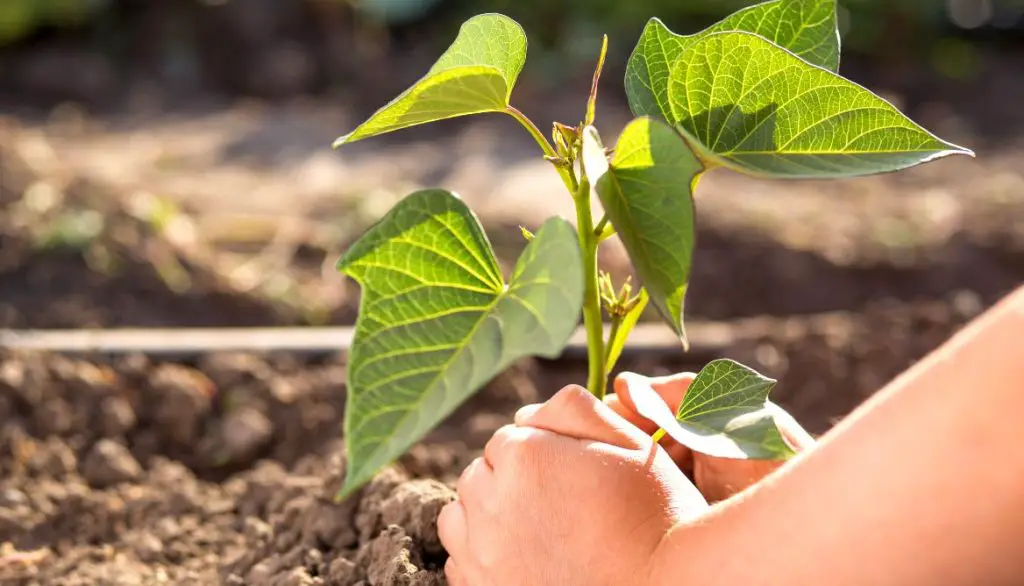
Caring For Your Sweet Potato Planter
Aside from frequent weeding and watering, planted sweet potatoes don’t take much care. Fortunately, the robust vines effectively reduce weeds. There are some factors that need to be considered when caring for own sweet potato which would be stated below.
1. Sunlight and Temperature
Sweet potato vines do not survive in cool climates and grow best in sunny places with warm nights and well-drained soil with a temperature of around 75 degrees. Its plants prefer lots of sunshine and warm evenings. A few days of temps below 40°F can severely injure or even kill vines. The best optimal rainfall for this is thought to be 700-1000 millimeters.
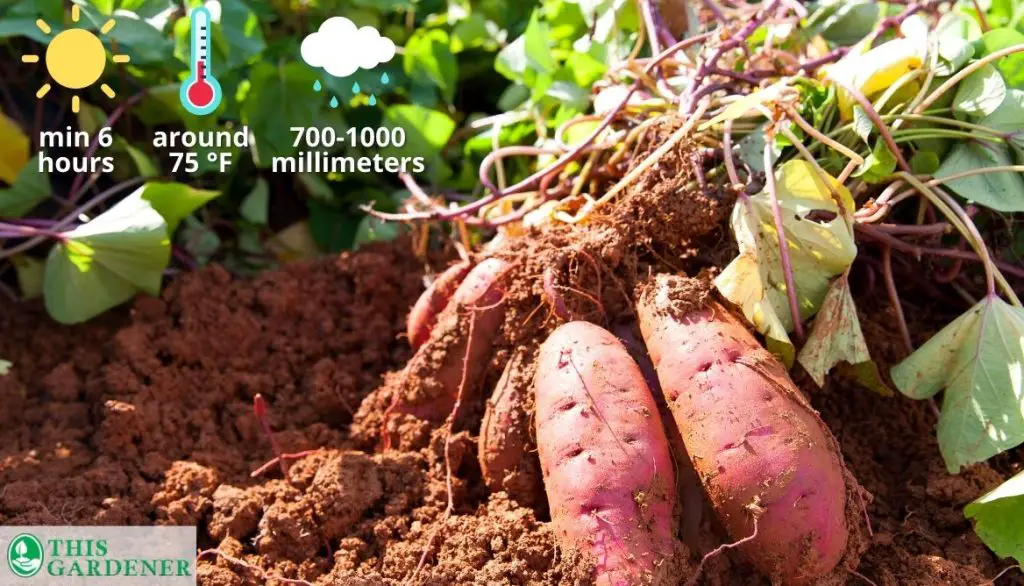
2. Watering
Sweet potato vines are drought-tolerant, although they grow more vigorously when watered frequently. Water that is enough to keep the soil moist but not soggy. Sweet potato leaves will wilt when the plant is thirsty.
3. Fertilizing
Normal doses of fertilizer for sweet potatoes are normally approximately 1.25 to 2.25 pounds per foot when the soil is neither too low nor too rich in nutrients.
After this fertilization, you can wait four weeks before repeating the process, always using these proportions where potassium takes precedence over other nutrients and stop fertilizing about 3 weeks before they are harvested.
There is usually no need to fertilize planting beds if your keep the soil rich in organic matter or if you mix compost before planting.
4. Pruning
Unless you have mold, there is no need to prune growing sweet potatoes plant. Thin off around 20% of the leaves if necessary to facilitate air circulation.
Pruning the vines might be beneficial when their vines begin to overgrow your garden beds. Excessive foliage growth may result in lanky, thin root harvests. Cut off damaged, diseased, or overly long vines with scissors or pruners. To encourage bushier growth rather than wandering, cut just above the leaf nodes.
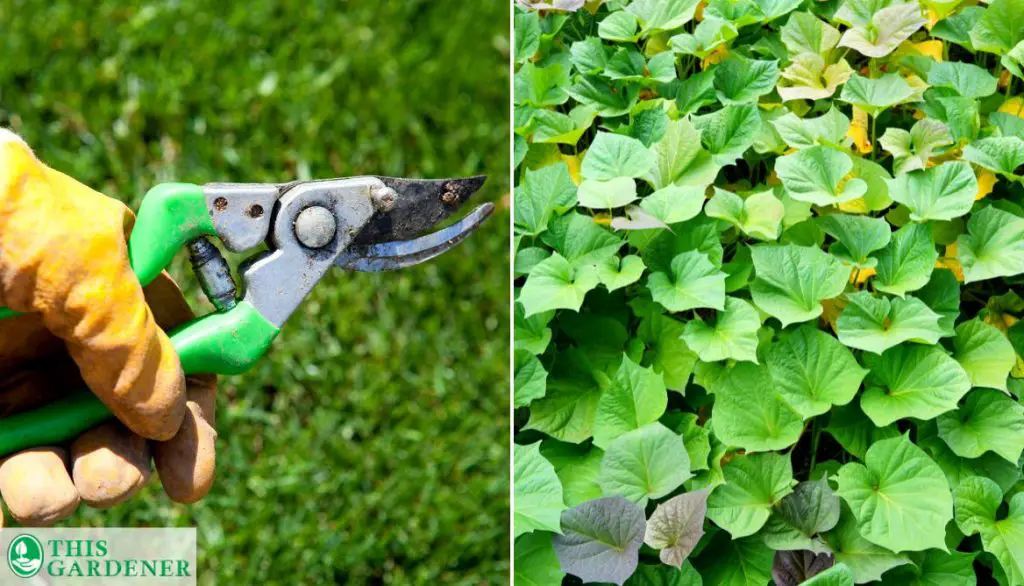
5. Harvesting Sweet Potatoes
Harvest tubers as soon as they grow large enough to eat, usually when the vine ends turn yellow. Before harvesting, trim back the vines using a mower, sharp knife or hand clippers. Then, gently pull roots from the ground using a broad fork or spading fork. The skins will be fragile at first, it is critical to treat them carefully and avoid scratching them.
6. Troubleshooting of Sweet Potatoes
One of the most common issues is overwatering because it is susceptible to drought for the first 50 to 60 days after planting. Tubers will be dwarfed if there is too much water. Water evenly and consistently throughout the growing season is your best bet.
7. Growing Problems of Sweet Potato Plants
Some of the most typical problems seen with more sweet potatoes include the plant not producing, the plant or its leaves changing color, wilting, dying, growing spots, being bitten by bugs, or simply not growing correctly.
To avoid most of these problems are proper monitoring of plant growth, appropriate application of fertilizers, mulching, suitable warm weather condition, early detection of diseases and pest actions application of fungicides, as well as appropriate soil and watering.
8. Pests Infestation
Several ground insects can harm the sweet potato root, including the sweet potato weevil, rootworms, wireworms, white grubs, white-fringed beetles, and flea beetles. The sweet potato weevil (Cylas spp.) is the most damaging pest of this crop. This weevil can lay up to 250 eggs in the roots or stems of the plant.
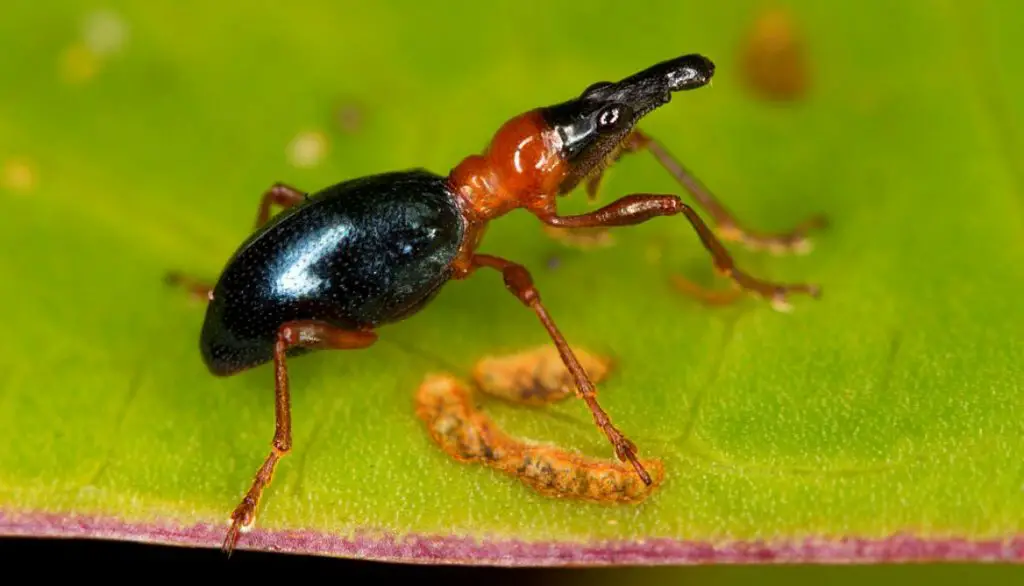
9. Diseases
This disease is caused by two viruses: sweet potato chlorotic stunt virus (SPCSV) and sweet potato feathery mottle virus (SPCVM) (SPFMV).
At least 75 diseases and nonparasitic illnesses affect the potato plant, several of which frequently cause output reductions in potato farming areas in the northeastern United States. Regular potatoes are a vegetatively propagated crop, and disease inoculum can be found in potato seed tubers.
10. Safety Measures
The most common danger is that the tubers can be contaminated with dangerous bacteria and viruses. The most efficient means of managing the illness is to use resistant varieties; if resistant varieties are not used, the soil should be kept at a low pH that is hostile to the pathogen, the diseased plant should be destroyed to prevent the spread, and pesticides should be sprayed.
The Ideal Storage Temperature for Sweet Potato Tubers
Potatoes should be stored at temperatures ranging from 55°F to 65°F (lower than their curing temperature). The ideal humidity level should be between 90% and 95%. With these temperature and humidity levels, the basement, cellar, or garage are the best storage locations for storing sweet potatoes.
FAQs
What size grow bag do I need for sweet potatoes?
Generally, a bag size to grow sweet potatoes can be 2.5 to 10 gallons. It depends on how many plants you are growing. For one plant in a bag, you can take a 2.5-gallon bag.
Can sweet potatoes be grown in grow bags?
Yes, you can grow sweet potatoes in bags.
What kind of container can I grow sweet potatoes in?
To grow sweet potatoes, you’ll need a large non-metal container. Clay pots are a good option because they also keep the soil moist.
How many months do sweet potatoes take to grow?
This can take anywhere from three to five months after planting, depending on the variety. Sweet potatoes mature at varying rates and might differ in maturity by many months. climate and cold weather have an effect as well.
How many sweet potatoes yield per plant?
Each plant can produce 5 to 10 pieces. Yields are determined by how well you care for your plants during the growing sweet potatoes season and the type of potatoes you cultivate.
Conclusion
Sweet potatoes are simple garden crops to grow if all of the basic requirements are satisfied, such as temperature, watering, soil, variety, and fertilization. Growing sweet potatoes in planting bags is one of the finest ways to grow them as it yields the most tubers.
The best grow bag for sweet potatoes is Gordita Bags because it is made from double heavy non-woven fabric, Reinforced handle design for easy movement, and has a large window that allows you to monitor the entire plant growth and easy harvesting of sweet potato tubers.
What type of bag would you go for if you need a garden bag, plastic or fabric? Let us know in the comment section. Thanks for reading!
- How to Get Potatoes to Sprout Eyes: Detailed Growing Guide with 3 Options - July 31, 2023
- Weight of a Medium Potato: Revealed in Detailed Guide - July 29, 2023
- Maris Piper Potatoes: 9 Substitutes You Should Know About - July 27, 2023
Hello! I’m Jessica Zander, a garden coach and consultant based in the Boston area (zone 6b), offering virtual consultations across the country and Canada.
I’ve been passionate about gardening since the early 1990s, and in 2022, I launched You Can Do It Gardening to empower individuals to feel more confident in their gardening endeavors.
Following a 30-year career in nonprofit finance and operations, I transitioned out of that field in mid-June of 2023 due to the growing demand for coaching services. Interestingly, my years of presenting financial statements to boards and finance committees proved to be valuable experience for teaching people about gardening! I enjoy sharing skills, providing guidance and suggestions, and collaborating efficiently with clients to make significant improvements to their outdoor spaces, both small and large. I also regularly teach at the Arlington Continuing Education and Cambridge Adult Education.
My approach is direct and practical, akin to Mary Poppins, but tailored to your garden. Clients find satisfaction in saving money and taking pride in their own gardening achievements.

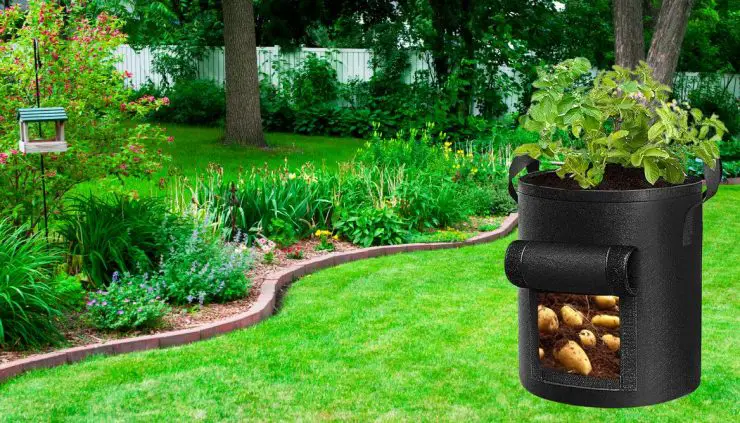



Add comment